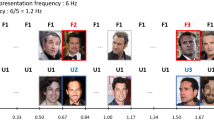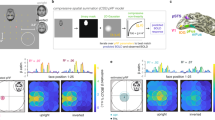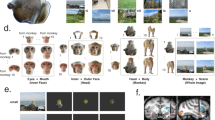Abstract
Functional imaging has revealed face-responsive visual areas in the human fusiform gyrus, but their role in recognizing familiar individuals remains controversial. Face recognition is particularly impaired by reversing contrast polarity of the image, even though this preserves all edges and spatial frequencies. Here, combined influences of familiarity and priming on face processing were examined as contrast polarity was manipulated. Our fMRI results show that bilateral posterior areas in fusiform gyrus responded more strongly for faces with positive than with negative contrast polarity. An anterior, right-lateralized fusiform region is activated when a given face stimulus becomes recognizable as a well-known individual.
This is a preview of subscription content, access via your institution
Access options
Subscribe to this journal
Receive 12 print issues and online access
$209.00 per year
only $17.42 per issue
Buy this article
- Purchase on Springer Link
- Instant access to full article PDF
Prices may be subject to local taxes which are calculated during checkout






Similar content being viewed by others
References
Bruce, V. & Humphreys, G. W. Recognizing objects and faces. Visual Cognition 1, 141– 180 (1994).
Damasio, A. R., Damasio, H. & Van Hoesen, G. W. Prosopagnosia: anatomic basis and behavioral mechanisms. Neurology 32, 331–341 (1982).
de Renzi, E. in Handbook of Research on Face Processing (eds. Young, A. W. & Ellis H. D.) 27–35 (Elsevier, Amsterdam, 1989).
de Renzi, E., Perani, D., Carlesimo, G. A., Silveri, M. C. & Fazio, F. Prosopagnosia can be associated with damage confined to the right hemisphere—An MRI and PET study and a review of the literature. Neuropsychologia 32, 893–902 (1994).
Ettlin, T. M. et al. Prosopagnosia: a bihemispheric disorder. Cortex 28, 129–134 ( 1992).
Meadows, J. C. The anotomical basis of prosopagnosia. J. Neurol. Neurosurg. Psychiatry 37, 489–501 ( 1974).
Warrington, E. K. & James, M. An experimental investigation of facial recognition in patients with unilateral cerebral lesions. Cortex 3, 317–326 (1967).
Desimone, R., Albright, T. D., Gross, C. G. & Bruce, C. Stimulus-selective properties of inferior temporal neurons in the macaque. J. Neurosci. 4, 2051–2062 (1984).
Harries, M. H. & Perrett, D. I. Visual processing of faces in the temporal cortex: physiological evidence for a modular organization and possible anatomical correlates. J. Cogn. Neurosci. 3, 9–24 (1991).
Rolls, E. T. & Baylis, G. C. Size and contrast have only small effects on the responses to faces of neurons in the cortex of the superior temporal sulcus of the monkey. Exp. Brain Res. 65, 38–48 (1986).
Grady, C. L. et al. Age-related reductions in human recognition memory due to impaired encoding. Science 269, 218– 221 (1995).
Haxby, J. V. et al. Face encoding and recognition in the human brain. Proc. Natl. Acad. Sci. USA 93, 922– 927 (1996).
Haxby, J. V. et al. Dissociation of object and spatial visual processing pathways in human extrastriate cortex. Proc. Natl. Acad. Sci. USA 88, 1621–1625 (1991).
Clark, V. P., Maisog, J. M. & Haxby, J. V. fMRI study of face perception and memory using random stimulus sequences. J. Neurophysiol. 79, 3257–3265 (1998).
Kanwisher, N., McDermott, J. M. & Chun, M. The fusiform face area: a module in human extrastriate cortex specialized for face perception. J. Neurosci. 17, 4302–4311 (1997).
McCarthy, G., Puce, A., Gore, J. C. & Allison, T. Face-specific processing in the human fusiform gyrus. J. Cogn. Neurosci. 9, 605–610 (1997).
Puce, A., Allison, T., Asgari, M., Gore, J. C. & McCarthy, G. Differential sensitivity of human visual cortex to faces, letterstrings, and textures: a functional magnetic resonance imaging study. J. Neurosci. 16, 5205– 5215 (1996).
Kanwisher, N., Tong, F. & Nakayama, K. The effect of face inversion on the human fusiform face area. Cognition (in press).
Tempini, M. L. et al. The neural systems sustaining face and proper-name processing. Brain 121, 2103–2118 (1998).
Davies, G., Ellis, H. & Shepherd, J. Face recognition accuracy as a function of mode of representation. J. Appl. Psychol. 63, 180– 187 (1978).
Kemp, R., Pike, G., White, P. & Musselman, A. Perception and recognition of normal and negative faces - the role of shape from shading and pigmentation cues. Perception 25, 37 –52 (1996).
Cavanagh, P. & Leclerc, Y. G. Shape from shadows. J. Exp. Psychol. Hum. Percept. Perform. 15, 3– 27 (1989).
Johnston, A., Hill, H. & Carman, N. Recognizing faces: effects of lighting direction, inversion, and brightness reversal. Perception 21, 365–375 (1992).
Bruce, V. & Langton, S. The use of pigmentation and shading information in recognizing the sex and identities of faces. Perception 23, 803–822 ( 1994).
Biederman, I. & Kalocsai, P. Neurocomputational bases of object and face recognition. Phil. Trans. R. Soc. Lond. B Biol. Sci. 352, 1203–1219 (1997).
Wiskott, L. & von der Malsburg, C. Recognizing face by dynamic link matching. Neuroimage 4, S14–S18 ( 1996).
Sinha, P. & Poggio, T. Role of learning in three-dimensional form perception. Nature 384, 460– 463 (1996).
Brunas-Wagstaff, J., Young, A. W. & Ellis, A. W. Repetition priming follows spontaneous but not prompted recognition of familiar faces. Q. J. Exp. Psychol. [A] 44, 423–454 (1992).
Ellis, A. W., Young, A. W. & Flude, B. M. Repetition priming and face processing: priming occurs within the system that responds to the identity of a face. Q. J. Exp. Psychol. [A] 42, 495–512 (1990).
Young, A. W., Flude, B. M., Hellawell, D. J. & Ellis, A. W. The nature of semantic priming effects in the recognition of familiar people. Br. J. Psychol. 85, 393– 411 (1994).
Andreasen N. C. et al. Neural substrates of facial recognition. J. Neuropsychiatry Clin. Neurosci. 8, 139–146 (1996).
Kapur, N., Friston, K. J., Young, A., Frith, C. D. & Frackowiak, R. S. Activation of human hippocampal formation during memory for faces: a PET study. Cortex 31, 99–108 (1995).
Sergent, J., Ohta, S. & MacDonald, B. Functional neuroanatomy of face and object processing. A positron emission tomography study. Brain 1, 15–36 (1992).
Perrett, D. I. et al. Neurones responsive to faces in the temporal cortex: studies of functional organization, sensitivity to identity and relation to perception. Hum. Neurobiol. 3, 197– 208 (1984).
Courtney, S. M., Ungerleider, L. G., Keil, K. & Haxby, J. V. Transient and sustained activity in a distributed neural system for human working memory. Nature 386, 608– 611 (1997).
Damasio, A. R., Tranel, D. & Damasio, H. Face agnosia and the neural substrates of memory. Annu. Rev. Neurosci. 13, 89–109 (1990).
Haxby, J. V. et al. The functional organization of human extrastriate cortex: a PET-rCBF study of selective attention to faces and location. J. Neurosci. 14, 6336–6353 (1994).
Ungerleider, L. G. Functional brain imaging studies of cortical mechanisms for memory. Science 270, 769–775 ( 1995).
Sergent, J. in Handbook of Research on Face Processing (eds. Young, A. W. & Ellis, H. D.) 77–84 (Elsevier, Amsterdam, 1989).
Subramanian, S. & Biederman, I. Does contrast reversal affect object identification? Investigative Ophthalmol. Visual Sci. 38, 998 (1997).
Gauthier, I., Anderson, A. W., Tarr, M. J., Skudlarski, P. & Gore, J. C. Levels of categorization in visual recognition studied using functional magnetic resonance imaging. Curr. Biol. 7, 645–651 ( 1997).
Rizzo, M., Hurtig, R. & Damasio, A. R. The role of scanpaths in facial recognition and learning. Ann. Neurol. 22, 41–45 (1987).
Buckner R. L. et al. Functional-anatomic correlates of object priming in humans revealed by rapid presentation event-related fMRI. Neuron 20, 285–296 (1998).
Buckner, R. L. et al. Functional anatomical studies of explicit and implicit memory retrieval tasks. J. Neurosci. 15, 12– 29 (1995).
Raichle, M. E. et al. Practice-related changes in human brain functional anatomy during nonmotor learning. Cereb. Cortex 4, 8–26 (1994).
Schacter, D. L. & Buckner, R. L. Priming and the brain. Neuron 20, 185– 195 (1998).
Squire, L. R. et al. Activation of the hippocampus in normal humans: a functional anatomical study of memory. Proc. Natl. Acad. Sci. USA 89, 1837–1841 (1992).
Dolan, R. J. et al. How the brain learns to see objects and faces in an impoverished context. Nature 389, 596– 599 (1997).
Schacter, D. L. et al. Brain regions associated with retrieval of structurally coherent visual information. Nature 376, 587– 590 (1995).
Morton, J. Interaction of information in word recognition. Psychol. Rev. 76, 165–178 (1969).
Acknowledgements
The functional imaging laboratory and R.J.D. were supported by the Wellcome Trust, N.G. by the Fyssen Foundation, G.C.B. by the National Science Foundation, and J.D. by the Human Frontiers Science Program.
Author information
Authors and Affiliations
Corresponding author
Rights and permissions
About this article
Cite this article
George, N., Dolan, R., Fink, G. et al. Contrast polarity and face recognition in the human fusiform gyrus . Nat Neurosci 2, 574–580 (1999). https://doi.org/10.1038/9230
Received:
Accepted:
Issue Date:
DOI: https://doi.org/10.1038/9230
This article is cited by
-
Functional brain changes in Parkinson’s disease: a whole brain ALE study
Neurological Sciences (2022)
-
Inter-brain EEG connectivity in hyperscanning for Italian and French gestures: the culture-related nonverbal language
Culture and Brain (2022)
-
Modulation of the Emotional Response to Viewing Strabismic Children in Mothers—Measured by fMRI
Clinical Neuroradiology (2019)
-
Spatiotemporal neural network dynamics for the processing of dynamic facial expressions
Scientific Reports (2015)
-
Individual differences in solving arithmetic word problems
Behavioral and Brain Functions (2013)



